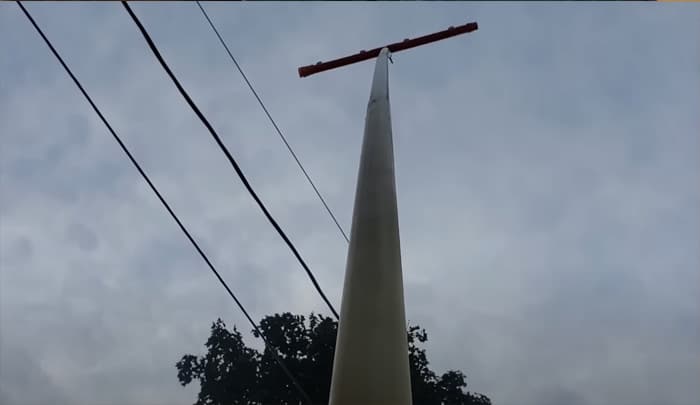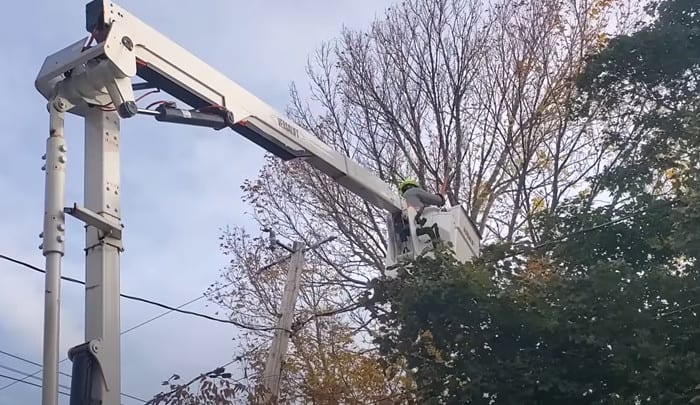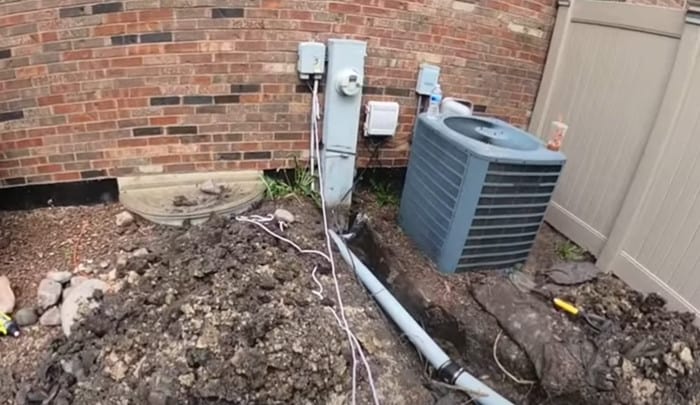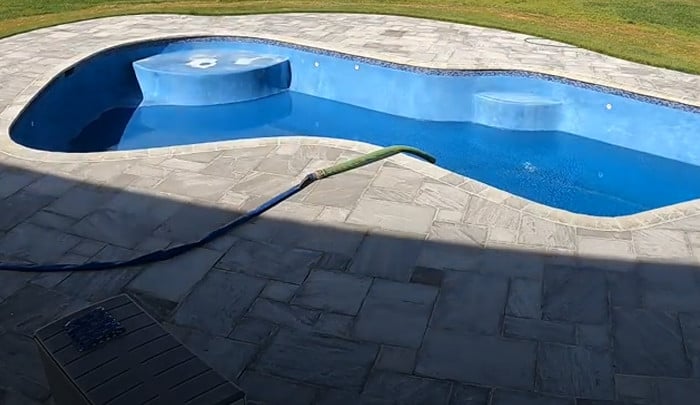Do you want to build your very own swimming pool but need to know how to move overhead power lines? Look no further. This step-by-step guide will show you how to move power lines safely so that your pool can be the oasis of your dreams! Whether you’re an experienced handyman or just a novice DIYer, moving power lines is a serious task that requires professional expertise. It’s crucial to understand the complexities involved, including standby power consumption and safety considerations. With the right professional help and guidance, you can ensure your pool is up and running safely and efficiently. So let’s dive in and take a look at how to move power lines for a pool.
- What is Involved in Moving Overhead Power Lines for a Pool?
- Checking Local Regulations, Requirements and Zoning
- Budgeting and Bidding the Project
- Safety Requirements for Overhead Power Line Relocation
- Moving Overhead Lines During Pool Installation
- Final Considerations and Tips
- Frequently Asked Questions and Answers
- References
You should always contact a qualified electrician to ensure the power lines are moved safely and securely. Additionally, it is important to check with your local utility company to receive permission before moving any overhead power lines.
“Moving overhead power lines is not a casual undertaking, it demands expertise, precision, and adherence to safety standards. But, with a certified professional, such as an Electrical Engineer, the process can be done safely without compromising the stability of the power grid and the integrity of your property.”
Jorsten Valentini, Electrical Engineer
What is Involved in Moving Overhead Power Lines for a Pool?
Moving power lines for a pool is a complex task that requires professional expertise and should never be attempted by homeowners. It’s crucial to understand the regulations and safety considerations, including the potential need for a generator for your house during the process. Before making any decisions, consult with certified electricians and local authorities. There are various points of consideration when it comes to moving overhead power lines for a pool, including the extent of the relocation, distance required to move the lines, potential disruption of service, danger of electrocution, cable type and age, complexity of the installation process, and cost.
On one hand, it can be beneficial as relocating existing power lines for a pool will improve visibility in the yard and can provide a more aesthetically pleasing space in which to entertain family and friends. On the other hand, moving overhead power lines for a pool poses potential risks such as causing disruption of service or even electrocution should the cables be installed in an unsafe manner. Hiring an experienced electrician is safest option in order to minimize these risks.
Before departing on this project, it’s important to check local regulations, requirements and zoning as they pertain to moving overhead power lines for a pool. The next section will provide further guidance provider on how to go about this process.

Checking Local Regulations, Requirements and Zoning
When installing an in-ground swimming pool, property owners should carefully consider their electrical needs, including how to power the pool pump and other equipment. This may involve assessing whether you need a whole house generator to ensure uninterrupted power supply. Depending on local regulations and distance from the house, this might also require moving overhead power lines, which is a complex process requiring professional assistance. Before beginning this process, it is important to check local regulations, requirements, and zoning.
In many cases, pool owners must obtain approval from the local authority before making any changes to existing power or utility lines. This is especially true in areas with strict rules concerning land use or when making major changes that impact adjacent properties. In some cases, the homeowner’s association may also have to be consulted before making any additions or alterations to existing utility services. If a property owner is unsure about what approvals are needed for power line movement, they should contact their local government for information about these requirements.
It is crucial to ensure that any changes to existing power or utility lines comply with local regulations and national building codes. This includes considering factors such as power outlet placement for your pool equipment. Any discrepancies could result in delays, fines, or safety hazards. Homeowners should always prioritize safety and leave the work to certified professionals when dealing with such utilities
.
After checking local regulations, requirements and zoning, the next important step in moving overhead power lines for a pool is inspection, permits and agreement; all of which will be discussed in the following section.
Inspection, Permits, and Agreement
In order to move overhead power lines for a pool, inspection and permits should be obtained prior to beginning any work. If the job involves substantial modifications or upgrades to existing utilities, a permit is typically needed from the local building department. Depending upon the area, this may include an electrical permit as well. It is important that all necessary inspections are performed to ensure the safety of both individuals involved in the project and people living near the site.
Furthermore, it is beneficial to get agreement with the utility company before beginning any construction or installation. The utility companies have certain guidelines regarding their equipment and modifications to it. Additionally, they have rights-of-way which must be observed. It is important to understand these agreements before performing any work. Negotiations will be necessary if access or alterations to the rights-of-way are requested by the property owner.
Once inspection, permits, and agreements have been secured, budgeting and bidding decide which contractor or contractor group is best for the project. Carefully considering budgeting constraints can significantly determine whether a good outcome is achieved or not. It is recommend that at least three bids are received and reviewed prior to selecting a contractor; this will help ensure there are no unexpected expenses later on in the process that could deplete allocated funds.
The next section of this guide will discuss budgeting and bidding in further detail, including how to evaluate potential contractors, necessary insurance coverage, required licenses, and ways to mitigate risks associated with projects involving overhead power lines for pools.

Budgeting and Bidding the Project
Budgeting and bidding the project is an important step in planning your pool installation. The budget includes all costs associated with the project including materials, labor, permits, and any other fees, such as a contractor’s license or insurance fees that may be required.
When preparing a budget for your pool installation, it is important to remember that certain elements of the project can require additional expenditure. For example, if you have to move nearby power lines to create more space for your pool, you need to consider their cost. Once the entire project has been planned and its associated costs determined, it’s time to prepare a bid request letter. This document outlines the funding requirements and should include any relevant permits or licenses needed.
One option when bidding the project is to contact multiple contractors who can provide quotes. Competitive bids can help ensure you get a fair price for your pool installation, as contractors compete for your business. When evaluating bids, consider factors beyond just price, such as experience with complex electrical work like installing refrigerators on the same circuit. If you decide to use only one contractor, make sure to discuss all aspects of the project, including potential electrical modifications, and negotiate terms before signing a contract.
Once you have finalized your bids from different contractors and chosen the most suitable one based on experience, cost and terms offered; it is important to review the contract thoroughly before signing it and agree on specific payment milestones throughout the project timeline.
Now that budgeting and bidding are complete, it’s time to find the right contractor for your pool installation project.
- According to HomeGuide, the average cost to move overhead power lines for a pool is $725 – $2,150.
- Power line relocation requires specialized equipment and certified electricians.
- Existing poles must typically be replaced by higher poles in order to meet underground code requirements.
Finding the Right Contractor
When it comes to relocating power lines for a pool, the safety of your home and family is paramount. That’s why it’s important to find a qualified contractor with experience in overhead power line relocation. Look for certified electricians who know how to identify which wires need to be moved and how to safely relocate them. Consider also hiring licensed contractors who understand local power line laws and regulations that are specific to the state or area.
Evaluate the contractor’s reviews, certifications, and references before you hire them. Don’t forget to ask if they have insurance that covers any damage done while moving the overhead power lines. The proof they are certified and experienced will help ensure costly mistakes don’t take place during the relocation process.
It’s important to select the right contractor, but don’t forget good customer service is just as important. An experienced contractor should be able to communicate clearly throughout each step of the process and keep you informed of what to expect next. This can save you from any potential frustration that often accompanies big projects like this one.
Now that you know how to find the right contractor, let’s move on to discussing safety requirements for overhead power line relocation.
Key Points
When relocating power lines for a pool, safety is paramount. Hire a qualified contractor with experience in overhead power line relocation that has good reviews, certifications, references, and insurance coverage. Good customer service is essential as an experienced contractor should be able to communicate clearly throughout the process and keep you informed. Safety requirements should also be discussed prior to relocating the overhead power lines.
Safety Requirements for Overhead Power Line Relocation
When moving overhead power lines for a pool installation, safety is the number one priority. Depending on the situation, it will be necessary to adjust, lower or raise those existing lines to ensure that anyone working in the area will be safe from potential electrocution and power-related injuries. It’s important to have all safety protocols implemented prior to beginning any type of line relocation project.
Before starting work, all professionals should receive appropriate training and be aware of all relevant safety protocols as outlined by the local power authority. This includes wearing protective gear when necessary, such as heavy gloves and rubber-soled shoes, as well as ensuring that any tools used to move the lines are properly insulated. Professionals should also adhere to all “No Climb” signage put in place by the power authority, always taking the utmost care when working near active or inactive power lines.
It is also recommended that no amateur attempts this type of job without professional help; this means not attempting to move any wires or poles without proper guidance, as this is potentially very dangerous and could cause serious injury or death. Careful planning and accurate measurements must also be taken into account before starting work in order to ensure a successful install.
Taking extra caution when dealing with overhead power lines is of utmost importance; neglecting proper protocols could lead to devastating consequences. With that being said, though it may require extra steps and authorization from an external party, properly adhering to safety requirements can save time and money in the long run while effectively protecting everyone involved in the process.
Now that we’ve delved into the important safety requirements needed in order to relocate overhead power lines for a pool installation, let’s move on to what’s next: Moving Overhead Lines During Pool Installation.
Moving Overhead Lines During Pool Installation
When installing a pool in your backyard, it’s important to consider the overhead power lines that may be present. It is highly recommended to move any nearby overhead power lines out of the way in order to make the installation process easier and safer. There are several options available when relocating overhead power lines and each requires careful consideration based on cost, timeline, risk involved and potential compliance with local codes.
One option is to hire a professional electrician or utility company to move the lines. This typically requires obtaining permits and licensing from the local authorities, which can add time and cost to the overall project. Another option is to use a space-saving solution such as a temporary construction light pole (TCLP) or an underground conduit encased in concrete that allows for adding additional lines or rerouting with minimum disruption. Although these solutions require less interference with existing infrastructure and often result in savings on labor costs, they can be very expensive up front due to purchasing the necessary equipment.
It is also worthwhile to take into consideration potential regulatory implications before proceeding with the project. Depending on location, there may need to be close coordination between contractors and utility companies to follow safety regulations and applicable laws regarding construction projects involving overhead electrical services. What’s more, local permitting requirements related to moving overhead lines could affect timelines as approval could potentially take weeks.
Ultimately, when deciding how to move overhead power lines for pool installation, it’s crucial to weigh all options carefully before making a decision. With careful planning and attention to detail, this task can become much smoother and hassle-free.
Now that we’ve discussed various ways of moving overhead power lines for pool installation, let’s take a look at some final considerations and tips in the next section.

Final Considerations and Tips
When it comes to moving overhead powerlines for a pool, there is no one-size-fits-all solution. Every project poses its own set of unique challenges. Before deciding on a course of action, homeowners should take an inventory of the current environment around their pool area and consider their personal goals. Understanding the legal regulations in your area is also an important factor when planning to move the lines.
Firstly, never attempt to undertake any work on the powerlines without further consulting a certified professional or experienced service technician. When handling electrical wiring, caution must always be taken to ensure safety for all people involved.
Doing the job yourself may be cheaper initially, but depending on circumstances it can prove to be more expensive down the road and potentially dangerous as well. Make sure you are familiar with local electric codes before starting any type of wiring job. Further, investigate whether your municipal electricity provider will grant permission or whether there are permits needed in order to complete the work.
For anyone considering burying new underground wires, costs associated with hiring heavy equipment, wires, PVC tubes and other materials must be considered alongside additional environmental regulations depending on location. There can also be added costs incurred due to utility company regulations, who may demand additional services like inspection after completion of the job.
For DIY enthusiasts who have an existing conduit and wiring in place near their pool area, verification checks can help identify if the wiring is still able to support anticipated loads from powering up a pool or equipment used in conjunction with it – such as pumps and lights. If there is any doubt about the existing wiring and conduit’s ability to handle additional load capacity then steps should also be taken for appropriate repairs and upgrading where necessary prior to attempting hookup of any kind.
Ultimately, dealing with powerlines for pools is highly specialized work and requires expert knowledge in both electrical engineering and local regulations. Professional contractors not only understand these regulations but make sure that everyone involved remains safe throughout the process by taking precautionary measures in their work flow. Their expertise is invaluable since they can quickly assess risks as well as identify potential problems often associated with this type of work that may not be immediately apparent to non-professionals.

Frequently Asked Questions and Answers
Are there any risks involved in moving overhead power lines for a pool?
Yes, there are risks involved in moving overhead power lines for a pool. The most important risk to consider is the possibility of electrocution or electric shock due to contact with the power lines. This can happen if the person working on the project is not properly trained in safety and electrical principles and does not take proper precautions. Additionally, there is the potential for fire or property damage if the work is performed incorrectly. The National Electric Code requires that all electrical work be performed by a qualified professional and in accordance with local building codes. Furthermore, it is important to note that many utilities companies require upfront payment for this type of work before beginning any project.
Is there any specific type of specialized equipment needed for moving overhead power lines for a pool?
Yes, there is specialized equipment needed for moving overhead power lines for a pool. For example, you will need an aerial lift to access the lines. You will also require specialty tools like cutters, cable ladders, and tensioners that are designed to handle the various types of power lines you’ll be dealing with. Depending on the size and complexity of the job, additional specialized items such as digger-derrick trucks, cranes, and other heavy equipment may be necessary. Finally, it’s important to make sure you have all the safety gear such as gloves, hardhats, face shields, and fall protection when working at height. In short, it requires an extensive array of specialized equipment to properly move overhead power lines for a pool.
What are the necessary steps for moving overhead power lines for a pool safely?
1. Contact your local power provider: Before attempting to move overhead power lines for your pool, contact your local power provider and inform them of the situation. They will be able to provide the best guidance on how to safely and legally move the power lines.
2. Make sure everyone is safe: Make sure everyone near the pool area is at a safe distance before beginning any work on moving or altering the lines.
3. Turn off the power: If possible, have the power provider shut off the power before beginning any work on the lines. This ensures that no one can be harmed if something goes wrong.
4. Demolish any existing structures: Any existing structures that may impede you from moving the lines need to be torn down first. This includes fences, trees, and other items that are in the way of moving or altering the lines.
5. Re-route power cables: After all necessary structures have been removed, begin re-routing the power cables to their new location. Be sure to always follow safety procedures when working with electricity and make sure nothing is tangled or overlapping with other potentially hazardous objects during re-routing.
6. Test for safety: After re-routing, have an expert electrician come out and do a thorough safety check of all connections and wiring to ensure nothing has been done incorrectly and everything is working properly before reconnecting the power.
7. Reconnect Power: Have your local electrician come out again once everything has passed inspection to ensure everything was re-connected safely and correctly, and then turn the power back on!
References
https://www.newhomesource.com/learn/how-do-you-install-a-pool-and-how-much-does-it-cost/





I remember around 20 years ago when I first had to move power lines for a DIY project. As long as you follow the safety measures thoroughly, and trust me on this, it isn’t as intimidating as it might initially seem.
I absolutely agree with you, Greyson, it’s all about properly following safety protocols, and then seemingly daunting tasks become quite doable.
As an electrician for more than 30 years, I can attest that although moving electrical lines seems daunting initially, strict adherence to safety regulations will make it fairly simple and hazard-free.
While I agree that sticking to safety rules is paramount when working around electricity, I’d argue that moving power lines is not a task for the well-intentioned DIYer, regardless of how detailed the guide may be. The risk is simply too great and it seems more prudent to hire a licensed professional who has been trained to handle such tasks properly.
I couldn’t agree more with you, Knox. As a retiree from the electrical industry, I can tell you that tasks involving power lines aren’t for DIY-enthusiasts. They require professional training and in-depth knowledge of safety, and even then the risks are significant.
While I respect the experience Zephyr brings to the table, I believe having my sons who are professional electricians conduct the task might not be as risky. Involving professionals doesn’t necessarily mean hiring from outside if you have the expertise within your family.